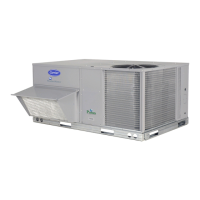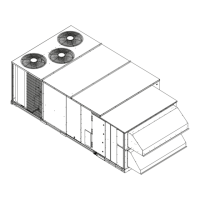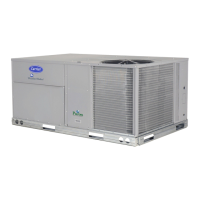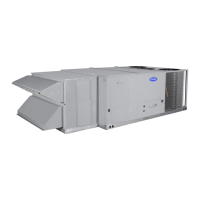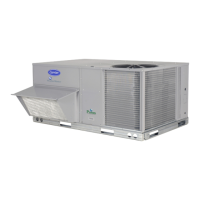51
Humidi-MiZer™ Troubleshooting
Use the unit scrolling marquee display or a CCN device to
view the cooling status display and the cooling diagnostic dis-
play (see Appendix A) for information on the cooling opera-
tion and the related Humidi-MiZer operation. Check the cur-
rent alarms and alarm history for any cooling alarm codes and
correct any causes. (See Table 14.) Verify any unique control
configurations per installed site requirements or accessories.
If alarm conditions are corrected and cleared, operation of the
compressors, fans, and Humidi-MiZer valves may be verified
by using the Service Test mode (see Table 6.) In addition to
general cooling service analysis (see Table 16), see Table 17
for general Humidi-MiZer service analysis.
NOTE: Wiring, operation, and charge are different on a Humidi-
MiZer unit compared to a standard unit.
Table 17 — Humidi-MiZer Service Analysis
PROBLEM CAUSE REMEDY
Subcooling Reheat Mode Will Not
Activate.
General cooling mode problem. See Cooling Service Analysis (Table 16).
No dehumidification demand. See No Dehumidification Demand, below.
CRC relay operation. See CRC Relay Operation, below.
Circuit RLV, CLV or LDV valve problem. See CLV, RLV or LDV Valve Operation, below.
Hot Gas Reheat Mode Will Not
Activate.
General cooling mode problem. See Cooling Service Analysis (Table 16).
No dehumidification demand. See No Dehumidification Demand, below.
CRC relay operation. See CRC Relay Operation, below.
Circuit RLV, CLV or LDV valve problem. See CLV, RLV or LDV Valve Operation, below.
Circuit RDV valve is not open. See RDV Valve Operation, below.
Outdoor temperature too low. Check Reheat2 Circuit Limit Temperatures
(Configuration
HMZR
RA.LO and RB.LO) using
ComfortLink scrolling marquee.
No Dehumidification Demand. Relative humidity setpoint is too low —
Humidistat
Check/reduce setting on accessory humidistat.
Relative humidity setpoint is too low —
RH sensor.
Check Space RH Setpoints (Setpoints
RH.SP and RH.UN)
and occupancy using ComfortLink scrolling marquee.
Software configuration error for accessory
humidistat.
Check Space Humidity Switch
(Configuration
UNIT
RH.SW) using ComfortLink’scrolling
marquee.
Software configuration error for accessory
humidity sensor.
Check RH Sensor on OAQ Input
(Configuration
UNIT
RH.S) using ComfortLink scrolling
marquee.
No humidity signal. Check wiring. Check humidistat or humidity sensor.
CRC Relay Operation. No 24V signal to input terminals. Check using Cool
Reheat1 Valve Test (Service
Test
HMZR
CRC) using ComfortLink scrolling marquee.
Check MBB relay output.
Check wiring.
Check transformer and circuit breaker.
No power to output terminals. Check wiring.
Relay outputs do not change state. Replace faulty relay.
RLV, CLV or LDV Valve Operation No 24V signal to input terminals. Check using Cool
Reheat1 Valve Test (Service
Test
HMZR
CRC) using ComfortLink scrolling marquee.
Check CRC Relay Operation.
Check Wiring.
Check transformer and circuit beaker or fuses.
Solenoid coil burnout. Check continuous over-voltage is less than 10%.
Check under-voltage is less than 15%.
Check for missing coil assembly parts.
Check for damaged valve enclosing tube.
Stuck valve. Replace valve. Replace filter drier.
RDV Valve Operation. (NOTE: Normally
Closed When De-energized)
No 24V signal to input terminals. Check using Cool
Reheat1 Valve Test (Service
Test
HMZR
RHV.A or RHV.B) using ComfortLink scrolling
marquee.
Check MBB relay output.
Check wiring.
Check transformer and circuit breaker or fuses.
Solenoid coil burnout. Check continuous over-voltage is less than 10%.
Check under-voltage is less than 15%.
Check for missing coil assembly parts.
Check for damaged valve enclosing tube.
Stuck valve. Replace valve. Replace filter drier.
Low Latent Capacity in Subcooling or
Hot Gas Reheat Modes.
CLV valve open or leaking. See CLV Valve Operation, above.
Low Sensible Capacity in Normal Cool
or Subcooling Reheat Modes.
RDV valve open or leaking. See RDV Valve Operation, above.
Low Suction Pressure and High
Superheat During Normal Cool Mode.
General cooling mode problem. See Cooling Service Analysis (Table 16).
RDV valve open or leaking. See RDV Valve Operation, above.
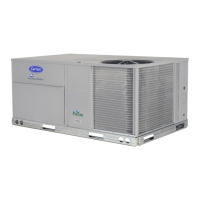
